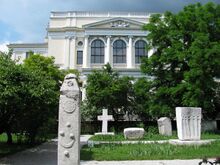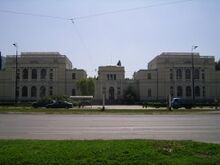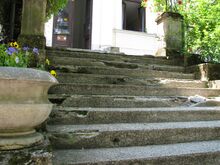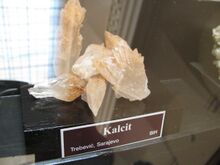National Museum of Bosnia and Herzegovina
Topic: Organization
 From HandWiki - Reading time: 10 min
From HandWiki - Reading time: 10 min
 | |
 Aerial photo of the National Museum - what is today backside of the complex (second row facing tree-alley) was main entrance and frontal facade before | |
| Established | 1888 (Conceived in 1850) |
|---|---|
| Location | Ulica Zmaja od Bosne 3 |
| Website | www.zemaljskimuzej.ba |
The National Museum of Bosnia and Herzegovina (Bosnian, Croatian and Serbian: Zemaljski muzej Bosne i Hercegovine / Земаљски музеј Босне и Херцеговине) is located in central Sarajevo, the capital of Bosnia and Herzegovina.
It was established in 1888, having originally been conceived around 1850 and expanded in 1913 by the Czech architect Karel Pařík adding four symmetric pavilions that contain the departments of archaeology, ethnology, natural history, and a library.
The museum is a cultural and scientific institution covering a wide range of areas including archaeology, art history, ethnology, geography, history and natural history. The Sarajevo Haggadah, an illuminated manuscript and the oldest Sephardic Jewish document in the world issued in Barcelona around 1350, containing the traditional Jewish Haggadah, is held at the museum. It has a library with 162,000 volumes.[1]
After being closed for several years due to heavy damage during the Bosnian War, the museum has re-opened and is in the process of mounting new and pre-existing exhibits.
Having remained open for its entire history including during the Bosnian War in the early 1990s, the museum was closed between 2012 and 2015 due to disagreements about funding.
Architecture
In 1913, the museum building was expanded by the Czech architect Karel Pařík who designed and added a structure of four symmetric pavilions with a facade in the Italian Renaissance Revival style. These pavilions enclosing a space in between forming a museum's specious courtyard. This courtyard is used as a botanical garden around which various stone monuments are exhibited. These monuments consist mostly of relocated stećaks. The four pavilions contain the departments of archaeology, ethnology, natural history, and a library.
History and governance
Museum development
The museum is a cultural and scientific institution in Bosnia and Herzegovina. Though conceived in 1850 as an idea by the Ottomans when they ruled Sarajevo, it was not until the rule of the Austro-Hungarian Empire (which captured modern day Bosnia and Herzegovina from the Ottomans in 1878) that the museum was officially established and built.[2]
1888–1913
Part of the Austro-Hungarian policy goals was to raise literacy levels and maintain European-standard education. Under their administration, a Museum Society was formed on February 1, 1888, in order to further this agenda in the form of a museum. The first director of the museum was Mr. Kosta Hörmann, an advisor to the Austro-Hungarian government. Greatly influenced by the orientation of 19th-century European science heuristics and culture, the museum's collection under Hörmann grew rapidly especially in the departments of natural history and archaeology. By the early 20th century, the museum began to outgrow its original premises and in 1908, construction on a new building to house the museum's collections began. Construction on the new building completed in 1913 and the museum was officially opened on October 4 of that year. Throughout this all, the museum was funded by the Austro-Hungarian's departments of education and culture as well as by private donations and charity events led by the Museum Society.[3]
1913–1991
With the opening of the museum in its new home in 1913 (where it still remains), its collections that varied from history, geography, archaeology (prehistoric, ancient and mediaeval), ethnology, history of art and natural history (biology, geology and mineralogy), and to some extent language, literature, statistics and bibliography, were divided into four buildings based on a new set of categories: Archaeology, Ethnology, Natural History, and the Library.
Two years later in 1914, as World War I began, the museum suspended its operations. After the end of the war in 1918, which was followed by the first union of the South Slavs, the museum resumed its operations under the administration of what was then called the Kingdom of Serbs, Croats and Slovenes, which was later known as Yugoslavia. Under this administration, which lasted during the interwar years of 1918–45, a hegemonic centralized administration was developed in which the judicial branch of government along with the Serbian bourgeoisie, paid very little economic and cultural attention to Bosnia and Herzegovina. This led to an abrupt socio-economic, political and cultural decay in Sarajevo as it found itself in the margins of the Kingdom. The National Museum thus lost much of its funding and clout and was beginning to lose its ability to maintain and archive its artifacts. As World War II approached in 1941 (and lasted until 1945), the National Museum's troubles further developed as its opportunities to operate diminished. It was during this war-time period that the National Museum experienced the least activity and development.[4]
After World War II, under a Socialist Yugoslavia, the National Museum made slow progress until the early part of the 1960s. Culture was declared to be of special importance for society by the Socialist Government and this period in time marked some of the National Museum's highest achievements in scientific research and publishing activities and exhibitions. (See the publications[5])
During this period, was significant the contribution of Museum's Natural departments in the development of the Movement “Science to Youth" – Alliance of Young Researchers of Bosnia and Herzegovina.
War years 1992–1995
The War in Bosnia and Herzegovina in 1992–95 not only ended the prolific activity of the National Museum, but it directly caused structural damage to the building. During this time, artillery shells crashed through the roof, 300 windows were broken, and many of its gallery walls torn down. Sections of the museum's artifacts and archives that could not be hidden were exposed to the elements or artillery. The museum's director at the time, Dr. Rizo Sijarić, was killed by a grenade blast on December 10, 1993, while he was arranging the holes in the museum's building to be covered by UN relief plastic sheeting.[6] Nevertheless, it never closed completely.
1995–2012
After the end of the war, the museum reopened as a work in progress thanks to numerous donations and contributions by: the Institute for Protection of Cultural Monuments and National Museum, the Historical and Natural Heritage of Bosnia and Herzegovina, UNESCO, the Federal Ministry of Education, Science, Culture and Sport,[7] the Institute for Planning and Construction of the City of Sarajevo, the International Peace Center in Sarajevo,[8] Swiss museums, Swiss ICOM and the Swiss National Museum in Zurich, BHHR, Norks Folkesmuseum from Oslo, the Swedish Cultural Heritage without Borders Foundation,[9] the Museum of Natural History, the Museum of Ethnography, the Museum of Islamic Art and other Swedish museums, as well as many others.
Closure 2012–2015
After 2010 the museum began to run out of funds; during 2011 the museum's 65 employees came to work for over a year without being paid.[10][11]
On Thursday, 4 October 2012, the National Museum of Bosnia and Herzegovina closed its doors completely and indefinitely, the first time in 124 years.[12][13] The Council of Europe noted: "After the war the different cultural groups, who define themselves as nations, have all wanted their own national cultural institutions.", leading to the neglect of the former national institutions such as the museum, the Historical Museum and the National and University Library.[14][15]
Demonstrations took place to protest the closure. Several students chained themselves to a pole in the lobby and remained inside, declaring they would stay there until the museum reopened, while dozens of others held a sit-in in front of the building.[16]
During the shutdown, staff continued to work unpaid, safeguarding the collection and the building.[17]
2015-
The museum reopened its doors to the public in September 2015, following an agreement between the different layers of Bosnia's complex government pledging financing for the museum and six other national cultural institutions.[18]
Departments and exhibitions
The Department of Archaeology
The Department of Archaeology includes sections for prehistory, ancient history, mediaeval history, documentation and a conservation laboratory. The archaeological collections document all aspects of human life in Bosnia and Herzegovina from the Old Stone Age to the late Middle Ages. The artifacts of the collections have mainly been collected during field research, though some have been acquired by exchange, gift or purchase.[19]
Exhibitions
Bosnia and Herzegovina in Ancient History, Bosnia and Herzegovina in the Middle Ages.[20]
The Natural History Department
The Natural History Department covers the flora and fauna and the geology of Bosnia and Herzegovina and elsewhere, consisting of around 2,000,000 specimens collected from field research, exchange, gift or purchase. The department consists of a Geology Section, a Zoology Section and a Botany Section, the latter including the Botanical Garden.[21]
Exhibitions
Botanical Garden, Pleistocene and subfossil vertebrates of Bosnia and Herzegovina, Fauna of mountain rivers and streams, Cave fauna, Minerals, Rocks and ores, Flora and fauna of Bosnia and Herzegovina, Higher fungi (Macromycetes, Medicinal plants and endemic plants of the Dinarides, Mammals, Invertebrates and Birds of Bosnia and Herzegovina.[22]
The Ethnology Department
The Ethnology Department is responsible for collecting, preserving, exhibiting and studying all aspects of the material, spiritual and social culture of the peoples of Bosnia and Herzegovina. Since 1913, the department has been arranged to illustrate a traditional urban house in Bosnia and Herzegovina. The collection of ethnological material began when the museum was established in 1888, with the purchase of some very valuable ethnological artifacts such as sets of traditional costume. The department is engaged in museological work, scientific research and educational work.[23]
Exhibitions
Dioramas and models, The life and Culture of Bosnia and Herzegovina's Urban Population in the 19th century, Which shirt is mine? - temporary exhibition.[24]
Botanical garden and the courtyard
A building is designed of four symmetric pavilions with a facade in the Italian Renaissance Revival style. Pavilions enclosing a space in-between forming a museum's courtyard.
Exhibitions
A courtyard is specious and used to house a botanical garden. Around are exhibited various stone monuments, mostly relocated stećaks among which is one of the most important examples, the Zgošća Stećak and the Zgošća Pilar.
The Library of the National Museum
The Library of the National Museum of Bosnia and Herzegovina was opened in 1888 as the first scientific library in Bosnia and Herzegovina. It contains about 250,000 publications (journals, periodicals, books, newspapers) in the fields of archaeology, history, ethnology, folklore, mineralogy, geology, botany, zoology and museology. Publications are now exchanged with 341 institutions.[25]
Sarajevo Haggadah
The Sarajevo Haggadah, a 600-year-old Jewish manuscript, and one of Bosnia's most prized relics, is housed in a high-security glass case.[26] The manuscript, handwritten on bleached calfskin, dates to the once-thriving Jewish community in Spain and describes events ranging from the Creation to the Jewish exodus from ancient Egypt to the death of Moses.[27] It is estimated to be worth over 700 million dollars.[28]
New York's Metropolitan Museum of Art offered in November 2012 to host the relic for three years, but the country's Commission for the Preservation of National Monuments rejected the offer due to the unresolved legal status of the National Museum. Additionally, moving the document to New York would have required special care, for which the funds needed to prepare for the transfer were unavailable.[29]
Herald of the Museum and journals
The Herald of the National Museum of Bosnia and Herzegovina (Bosnian: Glasnik Zemaljskog Muzeja Bosne i Hercegovine) is the oldest scientific journal in the country, with a first issue published on 1 January 1889. Herald was published quarterly, and its first editor was Kosta Hörmann.
- Glasnik Zemaljskog Muzeja Bosne i Hercegovine English: Herald of the National Museum of Bosnia and Herzegovina
- Anali Zemaljskog Muzeja Bosne i Hercegovine u Sarajevu English: Annals of the National Museum of Bosnia and Herzegovina
Publications
- "Zbornik srednjovjekovnih natpisa Bosne i Hercegovine" I (1962), II (1964), III (1964), IV (1970)
- Sergejevski, D.: "Bazilika u Dabravini" (1956)
- Benac, A. & Čović, B.: "Glasinac" I (1956), II (1957)
- Pašalić, E.: "Antička naselja i komunikacije u BiH" (1960)
- Čulić, Z. : "Narodne nošnje u BiH" (1963)
- Buturović, Đ.: "Narodne pjesme Muslimana u BiH" (1966)
- Vuković, T. & Ivanović, B.: "Slatkovodne ribe Jugoslavije" (1971)
- Đurović, E, Vuković, T. & Pocrnjić, Z. : "Vodozemci BiH" (1979)
- Šilić, Č.: "Monografija rodova Satureja L, Calamintha Miller, Micromeria Bentham, Acinos Miller i Clinopodium L. u flori Jugoslavije" (1979)
- Trubelja, F. & Barić, LJ. : "Minerali BiH" Vol. I, Silikati (1979)
- Čović, B.: "Pod kod BugojnA. Naselje bronzanog i željeznog doba u centralnoj Bosni" I: Rano bronzano dobA. (1991)
- Mediaeval tombstones of Bosnia and Herzegovina,
- "Radimlja", (1950) Benac, A.
- "Široki Brijeg", (1952) Benac A.
- Sergejevski, D. "Ludmer", (1952)
- Vego, M. "Ljubuški", (1954)
- "Anali Zemaljskog Muzeja Bosne i Hercegovine u Sarajevu" (1961, 1938 - 1962, 1963, 1964, 1966)
- "Spomenica stogodišnjice rada Zemaljskog muzeja BiH 1888 - 1988" (1988)
- Proceedings of the Scientific Conference "Minerali, stijene, izumrli i živi svijet BiH" (1988)
- International Symposium "Bosna i Hercegovina u tokovima istorijskih i kulturnih kretanja u jugoistočnoj Evropi" (1988).
Notable staff
- Nada Miletić - archaeologist.
Gallery
Calcite crystal from Trebević on display at the museum
Smoke pipe made out of sepiolite from Prnjavor
Sarajevo Agate from Bentbaša region.
See also
- National Library of Bosnia and Herzegovina
- List of museums in Bosnia and Herzegovina
- Movement “Science to Youth" – Alliance of Young Researchers of Bosnia and Herzegovina
References
- ↑ Bosnia and Herzegovina - Libraries and museums
- ↑ "Establishment of the Museum". http://www.zemaljskimuzej.ba/o_nama/osnivanje_muzeja-en.php.
- ↑ "Establishment of the Museum". http://www.zemaljskimuzej.ba/o_nama/osnivanje_muzeja-en.php.
- ↑ "Development of the Museum". http://www.zemaljskimuzej.ba/o_nama/razvoj_muzeja-en.php.
- ↑ "Publishing Activity: National Museum of Bosnia and Herzegovina". http://www.zemaljskimuzej.ba/o_nama/izdavacka_djelatnost-en.php.
- ↑ Riedlmayer, András (July 1995). "Erasing the Past: The Destruction of Libraries and Archives in Bosnia - Herzegovina". Middle East Studies Association Bulletin. http://bmip.info/articles/erasing.pdf. Retrieved 17 March 2013.
- ↑ "Federal Ministry of Education, Science, Culture and Sport of Bosnia and Herzegovina". http://www.fbihvlada.gov.ba/english/ministarstva/kultura_sport.php.
- ↑ "International Peace Center in Sarajevo". http://www.euromedalex.org/fr/node/7626.
- ↑ "The Swedish Foundation: Cultural Heritage without Borders". http://www.chwb.org/index.php?articleId=23.
- ↑ "Bosnia's National Museum closes after 124 years". Yahoo! Finance. 4 October 2012. https://finance.yahoo.com/news/bosnias-national-museum-closes-124-years-111058100.html.
- ↑ "Bosnia's National Museum is latest victim of political funding crisis". The Guardian. 3 October 2012. https://www.theguardian.com/world/2012/oct/03/bosnia-national-museum-funding-crisis.
- ↑ "Bosnia's National Museum closes after 124 years". Yahoo! Finance. 4 October 2012. https://finance.yahoo.com/news/bosnias-national-museum-closes-124-years-111058100.html.
- ↑ "Bosnia's National Museum is latest victim of political funding crisis". The Guardian. 3 October 2012. https://www.theguardian.com/world/2012/oct/03/bosnia-national-museum-funding-crisis.
- ↑ "Bosnia's National Museum is latest victim of political funding crisis". The Guardian. 3 October 2012. https://www.theguardian.com/world/2012/oct/03/bosnia-national-museum-funding-crisis.
- ↑ "STATUS UPDATES". http://www.cultureshutdown.net/status-updates/.
- ↑ "Bosnia's National Museum closes after 124 years". Yahoo! Finance. 4 October 2012. https://finance.yahoo.com/news/bosnias-national-museum-closes-124-years-111058100.html.
- ↑ "Bosnians urged to become guards at closed National Museum". Calvert Journal. 7 August 2015. http://www.calvertjournal.com/news/show/4516/bosnians-urged-to-become-guards-at-closed-national-museum-sarajevo. Retrieved 23 July 2018.
- ↑ "Bosnia revives landmark museum of ethnic treasures". Reuters. 16 September 2015. https://www.reuters.com/article/us-bosnia-museum-idUSKCN0RF2LN20150915.
- ↑ "Archaeology Department". National Museum of Bosnia and Herzegovina. http://www.zemaljskimuzej.ba/arheologija/index-en.php.
- ↑ "Archaeology Department". National Museum of Bosnia and Herzegovina. http://www.zemaljskimuzej.ba/arheologija/index-en.php.
- ↑ "Natural History Department". National Museum of Bosnia and Herzegovina. http://www.zemaljskimuzej.ba/prirodne_nauke/index-en.php.
- ↑ "Natural History Department". National Museum of Bosnia and Herzegovina. http://www.zemaljskimuzej.ba/prirodne_nauke/index-en.php.
- ↑ "Ethnology Department". The National Museum of Bosnia and Herzegovina. http://www.zemaljskimuzej.ba/etnologija/index-en.php.
- ↑ "Ethnology Department". The National Museum of Bosnia and Herzegovina. http://www.zemaljskimuzej.ba/etnologija/index-en.php.
- ↑ "Library of the National Museum of BiH". The National Museum of Bosnia and Herzegovina. http://www.zemaljskimuzej.ba/o_nama/biblioteka-en.php.
- ↑ "Bosnia's National Museum Shuts Its Doors, A Victim Of Dayton's Legacy". Radio Free Europe. 10 March 2012. http://www.rferl.org/content/bosnia-museum-set-to-close-doomed-by-dayton/24728638.html.
- ↑ Cerkez, Aida (13 February 2013). "Sarajevo Haggadah: Bosnia's Prized Jewish Manuscript Won't Show In NYC". Huffington Post. http://www.huffingtonpost.com/2013/02/06/sarajevo-haggadah-bosnia-prized-jewish-manuscript-wont-show-in-nyc_n_2632809.html.
- ↑ "Bosnia's National Museum Shuts Its Doors, A Victim Of Dayton's Legacy". Radio Free Europe. 10 March 2012. http://www.rferl.org/content/bosnia-museum-set-to-close-doomed-by-dayton/24728638.html.
- ↑ Cerkez, Aida (13 February 2013). "Sarajevo Haggadah: Bosnia's Prized Jewish Manuscript Won't Show In NYC". Huffington Post. http://www.huffingtonpost.com/2013/02/06/sarajevo-haggadah-bosnia-prized-jewish-manuscript-wont-show-in-nyc_n_2632809.html.
External links
- National Museum of Bosnia and Herzegovina, (in Bosnian)
- National Museum of Bosnia and Herzegovina, (in English)
- Library of the National Museum of Bosnia and Herzegovina, (in English)
- Digital Catalog of the National Museum of Bosnia and Herzegovina (in English and Bosnian)
[ ⚑ ] 43°51′16″N 18°24′09″E / 43.8545°N 18.4025°E
 |
 KSF
KSF














